| |
|
Getting started preventing MSIs The first steps in preventing musculoskeletal injuries (MSIs) is to identify risks in your workplace, assess those risks, and control them. You will also need to evaluate the effectiveness of the controls. Each of these steps is described below. The hierarchy of controls helps employers in selecting and developing effective risk control measures for MSI prevention. Use it as a guide to eliminate or reduce exposure to MSI risk factors. First and foremost, asking if the task needs to be done is an important starting point. Risk IdentificationFirst determine if, and/or where, a risk of MSI may be in your workplace. It is helpful to have a way of identifying the tasks for which prevention measures are the most urgent. Some of the things you can look at include:
Once you have determined where you may have risk of MSI, you can prioritize the areas, jobs, and/or tasks for risk factor identification and assessment. Jobs or tasks where employees have already sustained MSIs, or are experiencing signs and/or symptoms of MSI, should be dealt with first. Risk assessmentThe next step is risk assessment. There are a number of tools can be used to assess the risk of MSI. The risk assessment needs to be performed by an individual who has a good understanding of the work being assessed and the tools being used. The tools you choose for risk assessment should assess duration (how long), frequency (how often), and magnitude (how much) of the risk factors. Together these determine the level of risk (low, medium, or high) of MSI to the workers. To be successful at preventing MSI, you’ll need to consult with workers each step of the way. During the assessment, ensure that consultation occurs not only with workers who have signs and symptoms of MSI, but also with a representative sample of those performing the work. A representative sample might include workers of different ages, genders, heights, shift schedules, experience levels, and work locations. Risk ControlOnce the risk assessment has provided insight into the risk factors creating the greatest risk of MSI during each job or task. Those factors then need to be controlled — eliminated, or minimized — to reduce the risk of MSI. Consulting with workers to determine effective controls will ensure the greatest chance for success in implementing controls and reducing MSI. Although there will likely be a number of risk control options, consider selecting and developing effective risk control measures for MSI prevention according to the hierarchy of controls, which starts with the most effective controls (elimination or substitution), going down to the least effective (personal protective equipment). Successful implementation of any risk controls requires that workers be trained on the controls before they are implemented.  Evaluation Finally, you will need to monitor the effectiveness of the controls you implement, ensuring that they are evaluated at least annually. Evaluation may need to occur earlier if any of the following arise:
Read more We're here to help For resources, please visit worksafebc.com/ergonomics. If you have questions about ergonomics, human factors or need help managing the risk of MSI in your workplace, please contact us at AskAnErgo@worksafebc.com | |
 |
WorkSafeBC, PO Box 5350 Stn Terminal, Vancouver BC V6B 5L5
